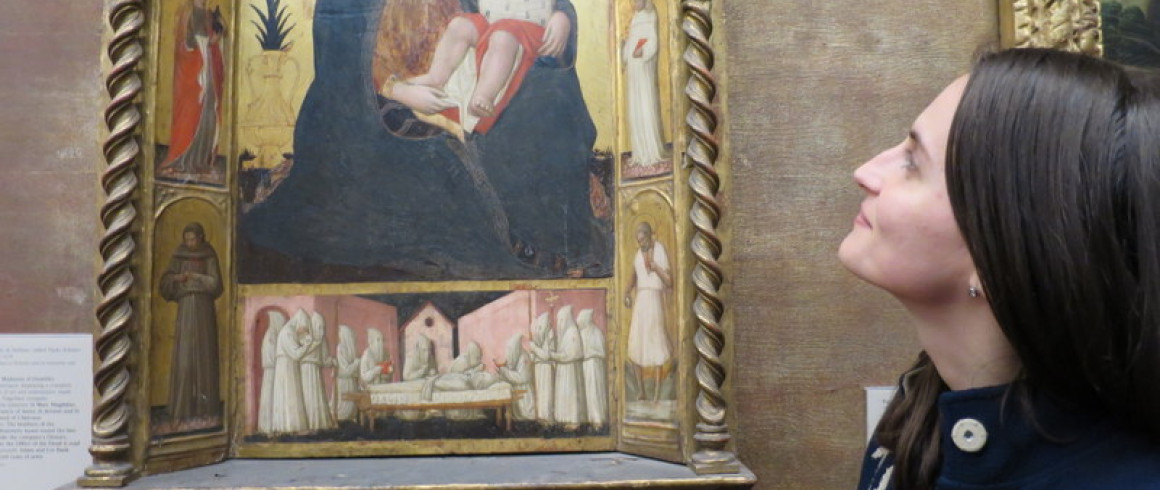Medieval musical manuscripts
The Easter vacation offers the perfect opportunity for Pembroke students to pop next door and take a stroll around the awe-inspiring galleries at the Fitzwilliam Museum.
http://instagram.com/p/0VXeX1jDUu/
For my tour, I have as a guide Pembroke graduate student Stephanie Azzarello (2014). Stephanie is studying for a PhD in Art History under the title ‘Celestial sounds, earthly deeds: illuminated choir books in late medieval Italy’. Here she describes her background and research:
Did you always want to study art history?
Growing up I thought I would be a professional pianist. Music was a huge part of my life for a long time, but at fifteen I realised that I needed to take a different path. After finishing my school studies I went to the University of Toronto. I thought I might become a psychologist but I took one course in art history and immediately knew that I had found my niche. I went on to do a Master’s at the Centre for Medieval Studies, University of Toronto, where I became fascinated by musical manuscripts produced in Italy during the High Middle Ages.
How did you come to specialise in Medieval Italian manuscripts?
One day a friend, knowing about my love of music, suggested that I submit an abstract for a conference on artistic depictions of music – images of musicians, paintings of musical instruments and musical manuscripts. I had never heard of musical manuscripts before so started Googling and from there discovered the amazing liturgical manuscripts produced by the monastery of Santa Maria degli Angeli, Florence. I fell in love with them immediately. I had always seen a connection between music and art; when playing Debussy piano works I would become interested in the French Impressionists, for example. However, it wasn’t something I had really explored until I found these manuscripts.

How did that bring you to Cambridge?
In January 2013, during my MA, Dr Stella Panayotova came to the Centre for Medieval Studies in Toronto as the Distinguished Visiting Scholar and I was asked to be her Research Assistant. She is Keeper of Manuscripts and Printed Books at Cambridge’s Fitzwilliam Museum. I asked if she would be willing to supervise me for a PhD on a new project I was thinking about concerning a set of sister manuscripts to the ones in Florence, the Murano choir books in Venice. It fitted perfectly with a project she had in mind and so here I am. I’ve always wanted to come to England, so that was perfect too. Everything just unfolded very naturally. I’m a big believer in ‘right liveliness’ – doing what you were meant to do – and I think it was an example of that.
What is your PhD project?
I am attempting to put the Murano Choirbooks back together. They were cut into individual folios that now exist in various collections: the Fitzwilliam Museum, London, Berlin, Paris, New York and further afield. I want to reconstruct them and also to put them into the wider social context of the time of their creation, which involves taking an interdisciplinary approach. I have to think about all kinds of elements: music, art, history, economics, palaeography and religion. I’m very aware that as an academic I look as these manuscripts but I don’t use them as the original audience would have done, but I really want to try and overcome that.
What made you choose Pembroke?
I really wanted to be in the place where the medieval period actually happened! Cambridge was also an obvious place for me because it has so much relevant material, so many of the experts in the field and it would be easy for me to get to the other locations in Europe that I need to visit. I knew that Pembroke was very supportive of art historians and it is in a great location for the Fitzwilliam Museum, where I have my supervisions. Being a part of the intellectual community here I have found it amazing to be surrounded by so many clever, engaged people who are as curious about your work as they are about their own.
 What is an average day like for you?
What is an average day like for you?
I feel so lucky to be here that I want to make sure I do the best work I can. That means I often work around 10 or 12 hours each day. I am currently working on a literature review, so in the morning I get up and spend two or three hours sitting in the Rosenthal Art Library in College reading articles in Italian. I am teaching myself to read the language from scratch, which is hard work but absolutely necessary. The footnotes often lead me to further sources that I go and hunt down in the University Library, so I mostly continue reading there in the afternoon. In the evening I’ll often tackle other work-related projects, like conference abstracts. I work seven days a week, but I might only do a few hours on Saturdays and Sundays.
What motivates you in your work?
I work on two artists in particular: Cristoforo Cortese and an artist that we know only as the Murano Master. I’m sure Cortese never imagined that 700 years after he died some plucky Canadian girl would be devoting all of her energy to understanding his work! But I want to pull his narrative forward, to keep the story going. That’s what we are all doing – trying to contribute to knowledge and together build something that really matters. I aspire to produce work like scholars such as Professor Evelyn Welch, Mirella Levi D’Ancona and my supervisors Dr Stella Panayotova and Dr Donal Cooper. In the meantime I’m just thrilled to be here doing what I love in the most incredible environment surrounded by the most supportive people.
For more information about the Medieval Manuscripts of the Fitzwilliam Museum, why not watch this video of Dr Stella Panayotova introducing the collection?
https://www.youtube.com/watch?v=2ZFkyP-0eMg
